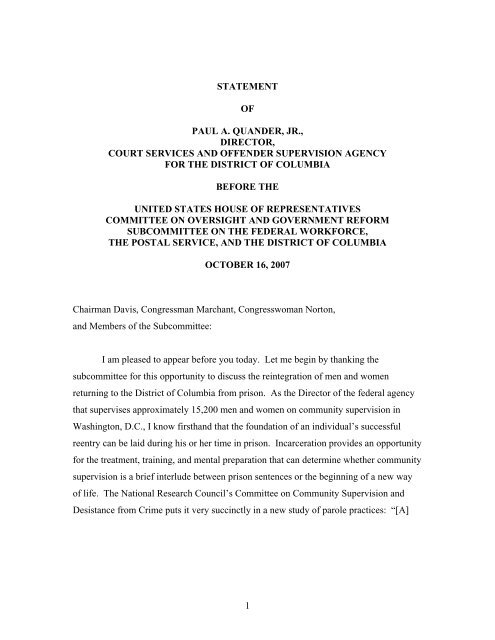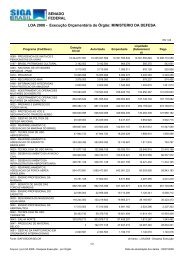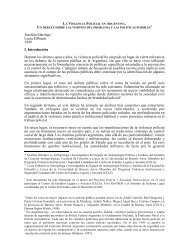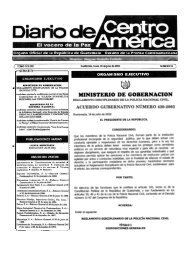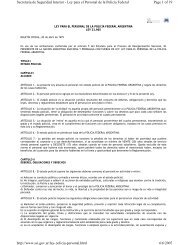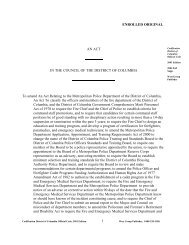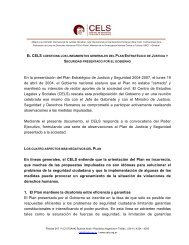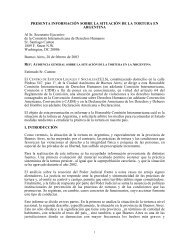Director of Court Services and Offender supervision Agency ...
Director of Court Services and Offender supervision Agency ...
Director of Court Services and Offender supervision Agency ...
Create successful ePaper yourself
Turn your PDF publications into a flip-book with our unique Google optimized e-Paper software.
STATEMENT<br />
OF<br />
PAUL A. QUANDER, JR.,<br />
DIRECTOR,<br />
COURT SERVICES AND OFFENDER SUPERVISION AGENCY<br />
FOR THE DISTRICT OF COLUMBIA<br />
BEFORE THE<br />
UNITED STATES HOUSE OF REPRESENTATIVES<br />
COMMITTEE ON OVERSIGHT AND GOVERNMENT REFORM<br />
SUBCOMMITTEE ON THE FEDERAL WORKFORCE,<br />
THE POSTAL SERVICE, AND THE DISTRICT OF COLUMBIA<br />
OCTOBER 16, 2007<br />
Chairman Davis, Congressman Marchant, Congresswoman Norton,<br />
<strong>and</strong> Members <strong>of</strong> the Subcommittee:<br />
I am pleased to appear before you today. Let me begin by thanking the<br />
subcommittee for this opportunity to discuss the reintegration <strong>of</strong> men <strong>and</strong> women<br />
returning to the District <strong>of</strong> Columbia from prison. As the <strong>Director</strong> <strong>of</strong> the federal agency<br />
that supervises approximately 15,200 men <strong>and</strong> women on community <strong>supervision</strong> in<br />
Washington, D.C., I know firsth<strong>and</strong> that the foundation <strong>of</strong> an individual’s successful<br />
reentry can be laid during his or her time in prison. Incarceration provides an opportunity<br />
for the treatment, training, <strong>and</strong> mental preparation that can determine whether community<br />
<strong>supervision</strong> is a brief interlude between prison sentences or the beginning <strong>of</strong> a new way<br />
<strong>of</strong> life. The National Research Council’s Committee on Community Supervision <strong>and</strong><br />
Desistance from Crime puts it very succinctly in a new study <strong>of</strong> parole practices: “[A]<br />
1
person should not leave prison without an immediately available…plan for postrelease<br />
life.” 1<br />
In 1997, the United States Congress passed legislation transferring responsibility<br />
for housing long-term prisoners sentenced under the District <strong>of</strong> Columbia Code to the<br />
Federal Bureau <strong>of</strong> Prisons (BOP). The transfer was completed in 2000. 2 Over 6,600<br />
District <strong>of</strong> Columbia inmates now serve their sentences in BOP facilities around the<br />
country. 3 The largest concentration, about 700 inmates, is housed in a BOP contract<br />
facility, the Rivers Correctional Institution in Winton, NC, operated by The GEO Group.<br />
The <strong>Court</strong> <strong>Services</strong> <strong>and</strong> <strong>Offender</strong> Supervision <strong>Agency</strong> (CSOSA) was created<br />
under the same legislation that transferred D.C. inmates to the BOP, <strong>and</strong> for much the<br />
same reason: to provide financial relief for the District <strong>of</strong> Columbia by shifting<br />
responsibility for a significant criminal justice function to the federal government.<br />
CSOSA encompasses the D.C. Pretrial <strong>Services</strong> <strong>Agency</strong>, as well as the adult probation<br />
<strong>and</strong> parole <strong>supervision</strong> functions.<br />
Most <strong>of</strong> the <strong>of</strong>fenders under CSOSA <strong>supervision</strong> have long histories <strong>of</strong> substance<br />
abuse, educational underachievement, <strong>and</strong> underemployment. Their initial risk<br />
assessments indicate that 42 percent feel they need substance abuse treatment (<strong>and</strong> 70<br />
percent have a documented history <strong>of</strong> drug use); 39 percent are under <strong>supervision</strong> for<br />
drug <strong>of</strong>fenses, <strong>and</strong> 20 percent have sought substance abuse treatment within the past six<br />
months. Only 56 percent have been employed during the past six months, <strong>and</strong> only 41<br />
percent possess a GED or high school diploma.<br />
With the resources it has received, CSOSA has improved community <strong>supervision</strong><br />
by lowering caseloads, implementing stringent contact st<strong>and</strong>ards <strong>and</strong> other close<br />
<strong>supervision</strong> strategies, increasing drug testing, opening multiple field <strong>of</strong>fices <strong>and</strong><br />
1 “National Research Council, Committee on Community Supervision <strong>and</strong> Desistance from Crime. “Parole,<br />
Desistance from Crime, <strong>and</strong> Community Integration.” Washington, DC: National Academies Press, 2007.<br />
(Advance copy cited.)<br />
2 A Corrections Information Council (CIC) was established within the D.C. Mayor’s Office in FY 2003.<br />
The CIC’s mission was to “represent the District’s interest in the well-being <strong>of</strong> its prisoners in U.S. Bureau<br />
<strong>of</strong> Prisons facilities.” To that end, the CIC proposed conducting regular inspections <strong>of</strong> BOP facilities<br />
housing D.C. inmates. The CIC, which might have played a useful role in monitoring services available to<br />
D.C. Code <strong>of</strong>fenders <strong>and</strong> coordinating post-release services delivery, has not met since February 2005.<br />
3<br />
As <strong>of</strong> May 31, 2007, according to the <strong>Court</strong> <strong>Services</strong> <strong>and</strong> <strong>Offender</strong> Supervision <strong>Agency</strong>’s Office <strong>of</strong><br />
Research <strong>and</strong> Evaluation.<br />
2
automating the case management system. In addition, CSOSA has been resourced to<br />
provide substance abuse treatment to a fraction <strong>of</strong> the <strong>of</strong>fenders that need it <strong>and</strong> to<br />
operate a modest learning <strong>and</strong> vocational service program that supplements the city’s<br />
overburdened public treatment <strong>and</strong> employment services capacity. In 2006, CSOSA<br />
opened a Reentry <strong>and</strong> Sanctions Center to provide intensive assessment <strong>and</strong> treatment<br />
readiness programming to both high-risk <strong>of</strong>fenders entering community <strong>supervision</strong> <strong>and</strong><br />
those at risk for revocation due to substance abuse. While CSOSA is still implementing<br />
some aspects <strong>of</strong> its program <strong>and</strong> only beginning to evaluate others, it is clear that<br />
community <strong>supervision</strong> has been transformed in the District <strong>of</strong> Columbia.<br />
On any given day, about 5,800 <strong>of</strong> the men <strong>and</strong> women under CSOSA’s<br />
<strong>supervision</strong> are on parole or supervised release. Upon their return to the community,<br />
these individuals choose a path leading either back to criminality or to stability <strong>and</strong><br />
productivity. Recent research on <strong>of</strong>fender reentry stresses that successful reintegration<br />
into society begins during incarceration. As BOP <strong>Director</strong> Harley G. Lappin stated in<br />
March, 2006 testimony before the United States Sentencing Commission:<br />
…[R]esearch has demonstrated conclusively that Bureau programs such as<br />
Federal Prison Industries, vocational training, education, <strong>and</strong> residential<br />
drug treatment have a positive effect on post-release recidivism.<br />
Specifically, these core inmate programs have been proven to substantially<br />
reduce recidivism, for as long as 12 years following release from<br />
prison….[F]or each dollar spent on inmate programs, taxpayers save<br />
substantial amounts <strong>of</strong> money through lower rates <strong>of</strong> recidivism: as much<br />
as $6.23 for prison industries programs, $7.13 for prison vocational<br />
training programs, $5.65 for prison education programs, <strong>and</strong> even $2.69<br />
for prison drug treatment programs.<br />
Clearly, the BOP recognizes that correctional programs can impact post-release success<br />
<strong>and</strong> provide taxpayer benefits.<br />
In planning how best to improve programs <strong>and</strong> services available to incarcerated<br />
men <strong>and</strong> women from the District <strong>of</strong> Columbia, several points need to be considered:<br />
Resources should be dedicated to relevant educational <strong>and</strong> vocational training<br />
programs at a specific facility, <strong>and</strong> then D.C. Code <strong>of</strong>fenders should be designated<br />
to, or transitioned through, that facility.<br />
3
Qualified staff must be hired <strong>and</strong> trained to deliver the programs, <strong>and</strong> program<br />
curricula must conform to BOP st<strong>and</strong>ards <strong>of</strong> quality <strong>and</strong> comprehensiveness.<br />
CSOSA should be involved in planning for post-release services, so that<br />
programming or treatment begun during incarceration can be continued in the<br />
community.<br />
With this in mind, if Rivers is to be the institution housing the most D.C. Code<br />
<strong>of</strong>fenders, CSOSA recommends the following program enhancements:<br />
Substance Abuse Treatment. CSOSA defines a clinically appropriate course <strong>of</strong><br />
treatment as including residential, transitional housing, <strong>and</strong> outpatient care, <strong>of</strong>ten<br />
with medical detox services as well. If more returning D.C. <strong>of</strong>fenders completed<br />
the BOP’s 500-hour residential treatment program, <strong>and</strong> if completion <strong>of</strong> the<br />
program could coincide with the inmate’s release to community <strong>supervision</strong>,<br />
CSOSA could then “pick up” services for most inmates with post-incarceration<br />
outpatient treatment <strong>and</strong> aftercare. For those <strong>of</strong>fenders with the highest risk<br />
levels, services could be continued through the Reentry <strong>and</strong> Sanctions Center.<br />
This level <strong>of</strong> coordination is consistent with best practices in reentry<br />
programming <strong>and</strong> addresses the most significant public safety threat posed by<br />
<strong>of</strong>fenders in the community. Researchers have established beyond question that<br />
drug use <strong>and</strong> crime are related, <strong>and</strong> that crime escalates in severity <strong>and</strong> frequency<br />
as drug use increases. 4 To coordinate prison-based <strong>and</strong> community-based<br />
treatment might enable a greater proportion <strong>of</strong> high-risk <strong>of</strong>fenders to receive<br />
effective treatment <strong>and</strong> reduce the substantial numbers <strong>of</strong> <strong>of</strong>fenders who are<br />
subsequently returned to incarceration due to drug use or drug-related crime. This<br />
could have a substantial impact on public safety.<br />
4 See in particular the research <strong>of</strong> James A. Inciardi <strong>of</strong> the University <strong>of</strong> Delaware, who has published<br />
extensively on the relationship between drug use <strong>and</strong> crime since the 1970s.<br />
4
The BOP treatment model has demonstrated results. The three-year<br />
outcome report found that inmates who receive treatment are more likely to avoid<br />
new arrest or revocation <strong>and</strong> maintain employment. 5<br />
Vocational Training. The Office <strong>of</strong> the D.C. State Superintendent <strong>of</strong> Education<br />
provides an HVAC training program funded with a Department <strong>of</strong> Education<br />
grant; however, the grant program limits participation to 18- to 24-year-olds. The<br />
University <strong>of</strong> the District <strong>of</strong> Columbia (UDC) recently launched a pilot program<br />
to provide vocational skills assessment <strong>and</strong> enhancement. Program participants<br />
are expected to continue their training at UDC after release. CSOSA worked with<br />
both UDC <strong>and</strong> Rivers to negotiate the Memor<strong>and</strong>um <strong>of</strong> Underst<strong>and</strong>ing that<br />
governs this program. These are very promising programs, but more training<br />
opportunities are needed.<br />
While employment is clearly an important part <strong>of</strong> successful reentry,<br />
recent research indicates that getting <strong>and</strong> keeping a job are complex problems.<br />
The Urban Institute’s longitudinal study <strong>of</strong> reentry, Returning Home, interviewed<br />
400 Illinois prisoners before <strong>and</strong> up to three times after their release. The study<br />
identified a cluster <strong>of</strong> issues that had a negative impact on employment: negative<br />
peer influences, prior revocations, lack <strong>of</strong> intimate relationships, drug or alcohol<br />
use, <strong>and</strong> neighborhood drug selling. The ability to maintain employment was<br />
related to overall life success <strong>and</strong> stability. Although most employed respondents<br />
were satisfied with their jobs a year after release, their wages averaged only $9.60<br />
per hour. 6<br />
In order to be as useful as possible to the <strong>of</strong>fender preparing to re-enter the<br />
work force, vocational training should be linked to real job opportunities, equip<br />
the inmate with skills that are in dem<strong>and</strong>, <strong>and</strong> incorporate training in techniques<br />
the <strong>of</strong>fender can use to combat negative influences, attitudes, <strong>and</strong> habits. As with<br />
substance abuse treatment, the training experience should span the entire reentry<br />
experience, beginning in prison <strong>and</strong> following the <strong>of</strong>fender into the community.<br />
5 Federal Bureau <strong>of</strong> Prisons. “BOP Triad Drug Treatment Evaluation Three-Year Outcome Report,” 2005.<br />
6 Kachnowski, Vera. “Returning Home Illinois Policy Brief: Employment <strong>and</strong> Prisoner Reentry.”<br />
Washington, DC: The Urban Institute, 2005.<br />
5
CSOSA has been working with the GEO Group <strong>and</strong> the BOP to develop programs<br />
that provide the skills needed in the D.C. job market <strong>and</strong> to link these programs<br />
with local employers <strong>and</strong> trade unions. Such linkages will provide returning<br />
inmates with the opportunity for continued training <strong>and</strong>, with it, better long-term<br />
career prospects. At this time, we are working with the Carpenters Union to<br />
develop a union-approved carpentry training program modeled on the recently<br />
implemented program at California’s Folsom State Prison. As in California, such<br />
a program could connect prison-based training with real post-release jobs. We<br />
hope this program will be the first <strong>of</strong> multiple successful efforts to bring<br />
vocational training to Rivers.<br />
The Washington, D.C. area economy is primarily knowledge- <strong>and</strong><br />
information-based. The D.C. Workforce Investment Council reported in 2005<br />
that approximately 70 percent <strong>of</strong> area employment is in the Business <strong>Services</strong><br />
sector (which encompasses information systems). Many D.C. <strong>of</strong>fenders possess<br />
significant educational deficits; only about half <strong>of</strong> the <strong>of</strong>fenders under <strong>supervision</strong><br />
have a high school diploma or GED. However, those that do should have training<br />
opportunities in the areas where they are most likely to find a job.<br />
BOP vocational programs range from under 100 hours to thous<strong>and</strong>s <strong>of</strong><br />
hours in duration <strong>and</strong> provide credentials ranging from a BOP certificate to<br />
Department <strong>of</strong> Labor-certified “apprentice” status. While it is difficult to define<br />
the capacity, duration, <strong>and</strong> content <strong>of</strong> programs that should be developed at<br />
Rivers, any development effort should take into account the average sentence<br />
served by Rivers inmates, which is 60 months. Based on the BOP’s March 2005<br />
“Occupational Training Programs <strong>Director</strong>y,” a range <strong>of</strong> programs, including<br />
Business Technology (500 hours), Culinary Arts (1500 hours), <strong>and</strong> the Computer<br />
Technology apprenticeship (4,000 hours) might be considered in addition to an<br />
apprenticeship program in the building trades.<br />
The BOP has developed a wide range <strong>of</strong> programs taught by full-time<br />
staff, adjunct instructors under contract, <strong>and</strong> through cooperative agreements with<br />
local colleges <strong>and</strong> trade schools. Each <strong>of</strong> these methods <strong>of</strong> program delivery<br />
should be considered for Rivers, which is located in a relatively isolated area.<br />
6
Counseling <strong>and</strong> Life Skills Programs. In addition to substance abuse, most<br />
inmates face significant behavior-based obstacles to successful reentry. Thirty-<br />
seven percent <strong>of</strong> <strong>of</strong>fenders under CSOSA <strong>supervision</strong> self-report a mental health<br />
issue ranging from recurrent depression <strong>and</strong> anxiety to a serious personality<br />
disorder. In addition, inmates need help preparing for the stresses <strong>of</strong> reentry.<br />
Programs that help <strong>of</strong>fenders manage situational stress <strong>and</strong> overcome ingrained<br />
errors <strong>of</strong> thinking, underst<strong>and</strong>ing, <strong>and</strong> behavior are just as necessary as job<br />
training or GED preparation; a recent Pennsylvania Department <strong>of</strong> Corrections<br />
study cites unrealistic expectations, anti-social attitudes <strong>and</strong> beliefs, <strong>and</strong> poor<br />
coping skills as the three most important underlying factors <strong>of</strong> parole violation. 7<br />
Inmates <strong>of</strong>ten lack the social <strong>and</strong> behavioral skills necessary to maintain a job.<br />
They may have significant problems with anger, motivation, or communication.<br />
The <strong>of</strong>fender is much less likely to succeed upon release if he carries with him the<br />
same flawed belief system <strong>and</strong> coping mechanisms that have served him so poorly<br />
in the past.<br />
CSOSA has collaborated with Rivers staff since the summer <strong>of</strong> 2003 to<br />
augment their release preparation program through two video conference<br />
programs. The CSOSA/Faith Community Partnership implemented video<br />
mentoring to link inmates nearing release from Rivers with faith-based mentors<br />
who provide pre-release encouragement <strong>and</strong> post-release support. We have also<br />
developed Community Resource Day, a quarterly video conference to provide<br />
inmates nearing release with information from local government <strong>and</strong> non-pr<strong>of</strong>it<br />
service providers in the critical areas <strong>of</strong> housing, health care, education, <strong>and</strong><br />
employment. Response to these programs has been very positive; however, they<br />
are just one element <strong>of</strong> a comprehensive release preparation program.<br />
The Revitalization Act launched a new era in the administration <strong>of</strong> justice in<br />
Washington, DC. By assuming the cost <strong>of</strong> housing <strong>and</strong> post-release <strong>supervision</strong> for<br />
7 Pennsylvania Department <strong>of</strong> Corrections, “Research in Review, Special Issue: PA DOC’s Parole Violator<br />
Study (Phase 2).” Harrisburg, PA: Pennsylvania Department <strong>of</strong> Corrections, December 2006.<br />
7
D.C.’s inmate population, Congress also invested in their post-release success. To realize<br />
a return on that investment, we must ensure that D.C. inmates have access to the<br />
resources they need, both before <strong>and</strong> after their return to our city. I look forward to<br />
continuing to work with the BOP <strong>and</strong> our other partners to improve the programs<br />
available at Rivers <strong>and</strong> other institutions.<br />
8
Filename: CSOSA testimony October 16_cleared.doc<br />
<strong>Director</strong>y: C:\Documents <strong>and</strong> Settings\childsm\Local<br />
Settings\Temporary Internet Files\OLK1<br />
Template: C:\Documents <strong>and</strong> Settings\childsm\Application<br />
Data\Micros<strong>of</strong>t\Templates\Normal.dot<br />
Title: A Concept for Providing Programs<br />
Subject:<br />
Author: Joyce McGinnis<br />
Keywords:<br />
Comments:<br />
Creation Date: 10/12/2007 5:21:00 PM<br />
Change Number: 2<br />
Last Saved On: 10/12/2007 5:21:00 PM<br />
Last Saved By: hendricksc<br />
Total Editing Time: 4 Minutes<br />
Last Printed On: 10/17/2007 3:03:00 PM<br />
As <strong>of</strong> Last Complete Printing<br />
Number <strong>of</strong> Pages: 8<br />
Number <strong>of</strong> Words: 2,079 (approx.)<br />
Number <strong>of</strong> Characters: 11,996 (approx.)


